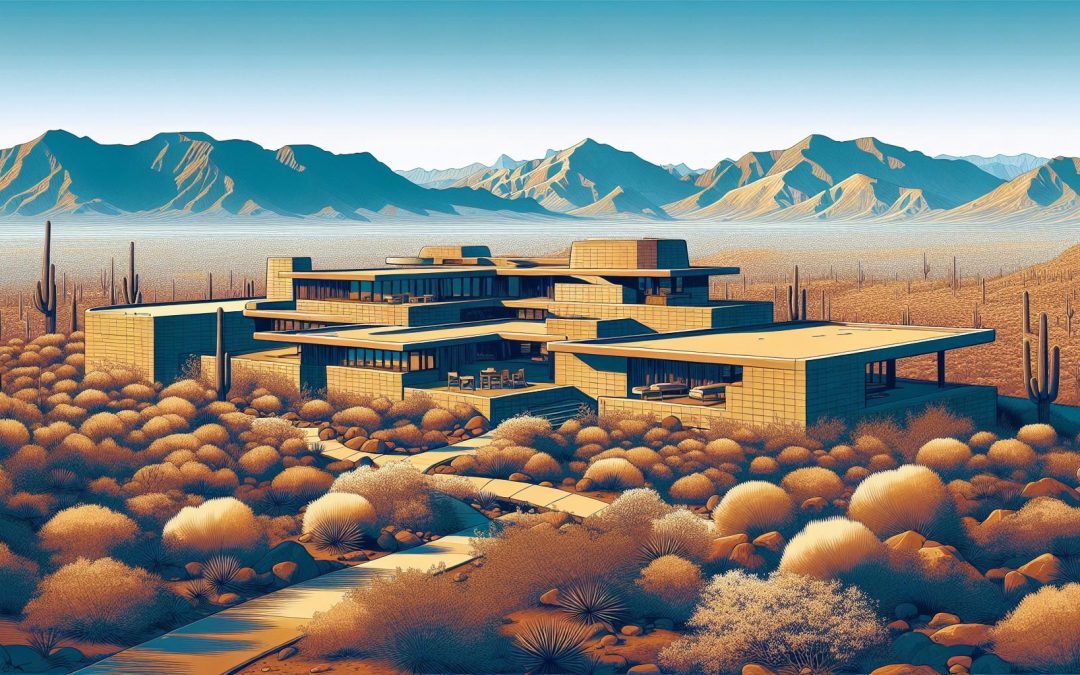Nestled in the heart of the Sonoran Desert lies a gem that’s not just an architectural marvel but a beacon of creativity and innovation. I’m talking about Taliesin West, the former winter home and studio of the legendary architect Frank Lloyd Wright. It’s a place where the boundaries of traditional architecture were pushed and redefined.
Exploring Taliesin West is like taking a step into Wright’s mind, where every corner and corridor tells a story of his vision for living in harmony with nature. It was here that Wright and his apprentices challenged the status quo, crafting a legacy that continues to inspire architects and designers worldwide. Let’s dive into the history and beauty of this iconic landmark.
History of Taliesin West
The journey to what is today known as Taliesin West began in 1937 when Frank Lloyd Wright, alongside his apprentices, set their sights on the foothills of the McDowell Mountains in Scottsdale, Arizona. This spot wasn’t chosen at random; Wright was deeply intrigued by the desert’s beauty and saw it as the perfect backdrop for a new kind of architectural expression.
Wright’s vision was clear: to create a space that wasn’t just an architectural masterpiece but a living, breathing example of how buildings could exist in harmony with the natural world. With this goal in mind, construction began, using local materials and embracing the desert environment. The structure’s walls were made from desert rocks, stacked within wooden forms and filled with concrete, showcasing an innovative technique that mirrored the textures and colors of the surrounding landscape.
This wasn’t merely a building project; it was an educational adventure. Taliesin West served as a winter home, studio, and architectural campus, where students of the Taliesin Fellowship could learn by doing. They were involved in the construction and modification of the site, an experience that Wright believed was essential to their education as architects. This hands-on approach was revolutionary and demonstrated Wright’s commitment to an immersive educational philosophy.
Over the years, Taliesin West has evolved. Initially envisioned as a winter home, it soon became a year-round haven for creativity and innovation. The location wasn’t just a place to live and work; it was a constantly evolving project that reflected Wright’s theories about organic architecture – the idea that man-made structures should exist in harmony with humanity and its environment.
The legacy of Taliesin West is not just in its innovative design or educational impact. It’s a reminder of Wright’s enduring belief in the importance of architecture that respects and enhances the natural world. This idea, so powerfully embodied in the desert of Arizona, continues to inspire and challenge architects and designers around the globe.
Architectural Features

When I first stepped onto the grounds of Taliesin West, I was immediately struck by its distinctive architectural features. Frank Lloyd Wright masterfully designed this landmark to be not just a structure, but a living embodiment of the desert environment that surrounds it.
One of the most striking features is how Wright incorporated natural light into every corner of Taliesin West. The use of translucent canvas ceilings, which were originally part of the structure, allowed soft, diffused light to fill the interior spaces. It’s fascinating how this design choice not only provided illumination but also helped to regulate the temperature inside, a clever nod to sustainability long before it became a global concern.
Another standout aspect is the use of local materials. Wright and his apprentices gathered rocks and sand from the desert to create the concrete used in the construction, ensuring the building would blend seamlessly with the landscape. This approach was revolutionary at the time and remains a core principle of sustainable and organic architecture today.
Wright’s philosophy of creating structures that were in harmony with humanity and its environment is evident in the organic forms and structures throughout Taliesin West. The sprawling complex doesn’t impose on the landscape but rather complements it, with low-slung buildings that follow the contours of the terrain and expansive windows that frame the stunning desert vistas.
The way Wright integrated indoor and outdoor spaces is another feature that makes Taliesin West so unique. He designed the terraces, gardens, and walkways to be extensions of the indoor environments, blurring the lines between inside and outside. This fluid transition not only enhances the beauty and functionality of the space but also reflects Wright’s vision of a living architecture that exists in harmony with the natural world.
Walking through Taliesin West, I couldn’t help but appreciate how these architectural features contribute to the site’s timeless appeal. It’s a brilliant fusion of form, function, and environment, a tangible expression of Wright’s genius that continues to inspire and influence.
Frank Lloyd Wright’s Vision
Frank Lloyd Wright, a name synonymous with groundbreaking architecture, had a vision for Taliesin West that went beyond its function as a personal winter retreat. He imagined it as a dynamic space where the boundaries between interior and exterior were blurred, inviting the sprawling desert landscape into every room. Wright’s meticulous attention to detail and his profound respect for nature were evident in every aspect of Taliesin West’s design.
From the outset, I was fascinated by how he utilized natural light and local materials to not just construct but rather sculpt an environment that celebrated the inherent beauty of the Arizona desert. The innovative use of translucent canvas for ceilings was revolutionary, allowing soft, diffused light to fill the space, creating a warm, inviting atmosphere that changed with the desert’s moods.
Wright’s philosophy of organic architecture was nowhere more apparent than in his choice of building materials. He insisted on using rocks and sand from the surrounding desert, ensuring that the building seemed to rise naturally from the ground. This harmony between the structure and its environment was a testament to Wright’s genius and his foresight in sustainable design.
The integration of indoor and outdoor spaces stood as a testament to Wright’s belief in the importance of living architecture. At Taliesin West, the walls seemed to dissolve away, connecting us directly with the vast desert beyond. This seamless integration of the building with its natural surroundings served not only as a haven for creativity but also as a constant reminder of our connection to the natural world.
Exploring Taliesin West, it’s clear that Wright’s vision was not just about creating a beautiful space, but about crafting an experience that stirred the soul, challenged conventional ideas about architecture, and celebrated the harmony between human habitation and the environment. This enduring legacy continues to inspire and influence, proving that truly visionary design is timeless.
Legacy and Influence
When I think about the impact Taliesin West has had, not just on architecture but on the way we perceive space and our environment, it’s truly monumental. Frank Lloyd Wright wasn’t just building a home or a studio; he was crafting an enduring philosophy that would stretch far beyond the desert landscape of Arizona. His vision for Taliesin West as a living, breathing entity continues to captivate and inspire.
One of the most compelling aspects of its legacy is its impact on sustainable architecture. Wright’s use of local materials and natural light was revolutionary at the time and laid a foundation for what would later become a major movement in architectural design. Wright believed in creating spaces that were not only beautiful but also in harmony with the environment. This philosophy resonates strongly today, as sustainable design principles have become increasingly important.
Furthermore, Taliesin West’s influence extends into the realm of architectural education. Wright was passionate about mentoring young architects, and the space served as a laboratory where ideas could be tested and refined. The apprenticeship program he founded there has evolved over the years but continues to attract students from around the world. They come seeking not just technical skills but a deeper understanding of Wright’s architectural ethos.
| Legacy Features | Impact |
|---|---|
| Sustainable Design Principles | Paved the way for modern sustainability in architecture |
| Integrated Indoor/Outdoor Spaces | Influenced contemporary design to embrace nature |
| Architectural Education | Continues to inspire and train future generations of architects |
Taliesin West’s legacy is not just confined to its physical form or its historical significance; it’s alive in the ongoing dialogue about how we design our spaces and how those spaces define us. Wright’s ideas about organic architecture, blending form and function, and creating harmonious environments continue to challenge and inspire architects and designers. As I explore the corners of Taliesin West, it’s clear that Wright’s spirit of innovation and his profound respect for nature still permeate every stone and beam.
Visiting Taliesin West

I’ve always dreamed of exploring architectural marvels up close, and Taliesin West by Frank Lloyd Wright was high on my list. When I finally made the trip, the experience was everything I’d hoped for and more. Nestled in the Scottsdale, Arizona desert, this historical landmark isn’t just an architectural feat; it’s a peek into Wright’s innovative mind and philosophy.
Stepping onto the property, I was first struck by how the structures seemed to emerge naturally from the desert landscape. Wright’s genius in integrating the indoor and outdoor environments was evident at every turn. The guided tours available are a must-do. They offer insightful details about Wright’s intentions and the innovative construction methods used. My guide was incredibly knowledgeable, explaining how local materials were utilized to ensure the complex blended seamlessly with its surroundings.
There are different types of tours you can choose from, depending on your interests:
- Insights Tour: A general overview of Taliesin West’s history and Wright’s design principles.
- Night Lights Tour: An enchanting evening tour showcasing the property illuminated beautifully against the night sky.
- Behind the Scenes Tour: Offers in-depth insights, including visits to areas usually not open to the public.
In addition to the tours, there are also workshop opportunities for those looking to dive deeper into Wright’s architectural principles. My visit during the cooler months was ideal, with the Arizona sun casting dramatic shadows across the stone structures, creating a mesmerizing visual spectacle.
As a testament to Wright’s legacy, Taliesin West isn’t just a static museum; it’s a vibrant learning center that continues to inspire and educate. The energy of ongoing creative work contributes to the unique atmosphere of this place, making it feel as alive and dynamic as it was in Wright’s time.
Conclusion
Visiting Taliesin West was more than just a walk through an architectural landmark; it was a journey into the genius mind of Frank Lloyd Wright. The guided tours and workshops offered a unique lens into Wright’s world, blending education with inspiration. As I walked the grounds, I couldn’t help but feel connected to the history and creativity that still pulses through the site. It’s a testament to Wright’s vision that Taliesin West remains not only a monument to his innovative spirit but also a vibrant hub for those eager to learn about architecture’s potential to harmonize with nature. Whether you’re an architecture buff or simply in search of a unique experience in Scottsdale, Taliesin West is a visit that’s sure to resonate long after you’ve left its sun-drenched paths.







